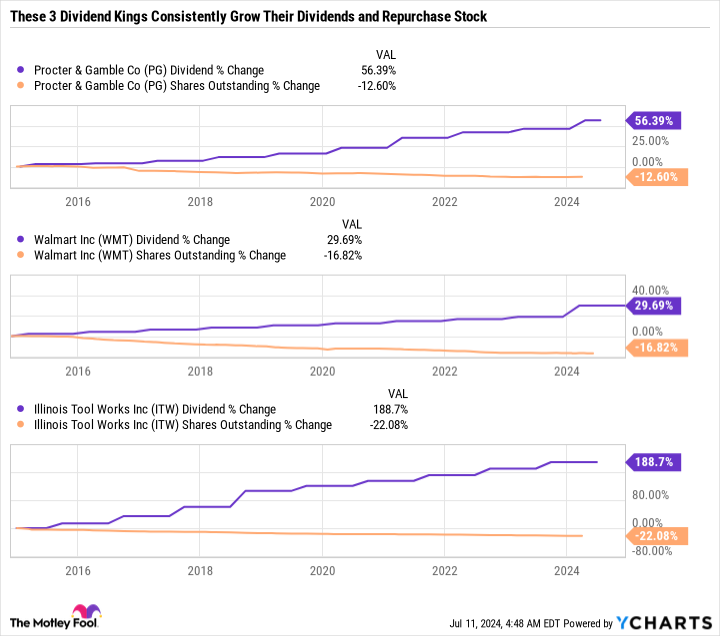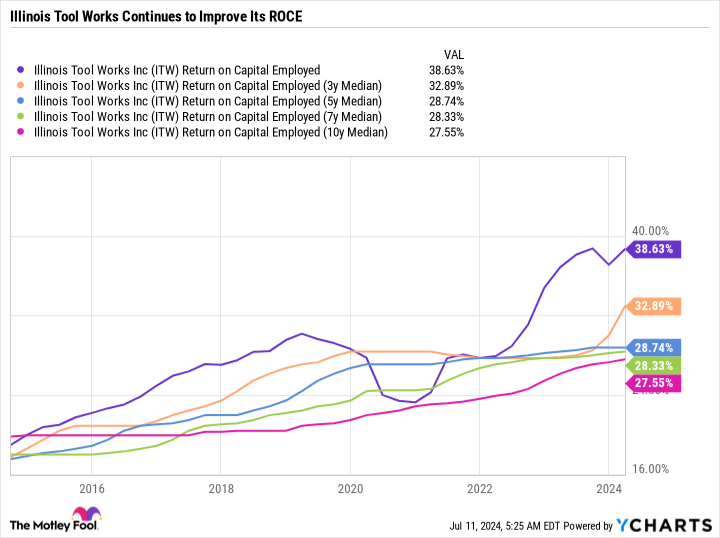Owning stocks with high yields can be a great way to generate passive income. But yields can swing wildly based on a stock’s price. A soaring stock’s yield will fall and a tumbling stock’s yield will rise, even as their payouts hold steady.
A much more useful approach for finding quality dividend stocks is to look at companies’ track records of dividend increases and their ability to grow their payouts in the future. Dividend Kings are companies that have raised their dividends annually for at least 50 years. Today, there are just over 50 members of that exclusive club.
Some of my favorites are Walmart (NYSE: WMT), Procter & Gamble (NYSE: PG), and Illinois Tool Works (NYSE: ITW). All three companies are well run and efficiently allocate capital. Here’s why they have what it takes to continue making annual dividend increases, and why all would be worth buying and holding for the next 20 years.


Walmart is entering its next phase of growth
Year to date, Walmart is the best-performing component in the Dow Jones Industrial Average — outpacing the impressive gains of Amazon, Microsoft, Apple, and others. It may surprise investors that such a stodgy retailer is outperforming megacap growth stocks in a growth-fueled market. But Walmart’s results speak for themselves.
The company has been flat-out executing during a time when many consumer-facing companies are struggling. Walmart has consistently grown its revenues, but it was seeing noticeable declines in its operating margin. Now, the retailer has reversed that downward trend and increased its operating margin above 4%. Higher revenues and an improved operating margin have helped Walmart boost its trailing 12-month operating income above $27 billion for the first time in nearly a decade.
There’s no single reason why Walmart’s results have been so strong, but broadly speaking, the company’s investments in itself are paying off. It nearly doubled its capital expenditures over the last five years, pouring money into new stores, existing store renovations, and Walmart+ — its e-commerce home delivery option. It has also focused on improving its product mix to better align with consumer behavior.
Sometimes, when a company rapidly ramps up its spending, investors will take a wait-and-see approach to those investments. However, the opposite is happening right now with Walmart. Walmart+ is delivering solid results, but there’s still room for improvement. Still, the potential for Walmart+ is undeniable. The subscription service leans on the company’s pricing power and increasingly efficient supply chain — it has effectively turned its stores into warehouses.
It’s no secret that the subscription model is powerful. After all, Costco Wholesale makes over half of its operating income from membership fees. So, if Walmart can generate recurring revenue and boost customer engagement, it could be a massive catalyst for future growth.
In February, Walmart raised its dividend by 9% and has ramped up the pace of its stock repurchases. Its yield at the current share price is just 1.2%, but the pace of dividend increases could accelerate if Walmart’s e-commerce and delivery investments translate to higher free cash flow.
Normally, I hesitate to get excited about a stock after it has experienced a massive run-up, but Walmart is putting on a capital allocation clinic. With a price-to-earnings ratio of 30.2, the stock is far from cheap, but Walmart arguably deserves a premium valuation.
P&G’s slow and steady business model is a winner
Procter & Gamble, commonly known as P&G, is a beautifully boring business. It owns a host of leading brands in home care and personal care. The company has done a masterful job of betting on its best brands and avoiding investing too heavily in new brands or making ineffective acquisitions — choosing instead to pass along its profits to shareholders through buybacks and dividends.
P&G has increased its dividend by 56% over the last decade and reduced its share count by 12.6%. It is also one of the longest-tenured Dividend Kings, with 68 consecutive years of dividend raises.
Procter & Gamble has demonstrated pricing power despite inflation pressures, which has helped its margins. But its sales volumes have been sluggish, which is understandable given the pressure on consumers.
The company might post somewhat unimpressive results in the near term. But in the long term, its portfolio of brands and deliberate spending should help it continue growing its earnings and dividend at a moderate rate.
P&G has paid $9 billion in dividends over the past year — giving it one of the highest dividend expenses of any U.S.-based company. Investors looking for a safe dividend stock should consider P&G and its 2.4% yield.
ITW’s high-margin segments help offset its cyclicality
Illinois Tool Works, commonly known as ITW, isn’t a household name like Walmart and P&G because the bulk of its products are purchased by industrial and commercial customers.
The industrial conglomerate has seven core segments — automotive, test & measurement and electronics, food equipment, construction products, welding, polymers & fluids, and specialty products. That’s a great deal of diversification. But what really makes ITW a standout are its growing margins across all of its segments — management’s guidance is for operating margin to be in the 26% to 27% range this year, and for it to grow to 30% by 2030.
ITW is an incredibly well-run business, as evidenced by its growing return on capital employed (ROCE). ROCE is a profitability metric that is calculated as earnings before interest and taxes divided by total assets minus current liabilities. It showcases a company’s ability to generate profits from capital, as well as manage debt.
ITW’s ROCE has skyrocketed to 38.6% thanks to its growing margins. In the following chart, you’ll notice that the company’s ROCE has steadily increased over time. For example, the three-year median ROCE is higher than the five-year, which is higher than the seven-year, and so on.
Unlike Walmart or P&G, ITW stock has lost value this year, pushing its P/E ratio down to just 23.3. Given its track record for growing margins and generating high returns on its capital, ITW stands out as one of the best Dividend Kings to buy and hold for decades to come.
Quality wins out in the long run
When searching for companies to buy and hold over the long term, it’s important to look past current valuations and focus more on where the businesses are headed. A company has to grow earnings to sustain dividend hikes and stock repurchases. If its earnings don’t grow at a decent pace, a company may have to take on debt to support its capital return program, or else cut its dividend.
Walmart, P&G, and ITW operate in different industries, but they share the common themes of dividend growth, stock buybacks, and effective capital allocation. All three companies are also excellent at playing to their strengths.
Walmart’s competitive edge is its pricing model built around value. It is now leveraging that pricing model through a growing home delivery service. P&G and ITW have portfolios of high-margin brands and have done excellent jobs of not over-expanding or compromising the quality of their revenue.
Add it all up, and all three stocks stand out as excellent passive income opportunities you can confidently buy and hold for decades.
Should you invest $1,000 in Walmart right now?
Before you buy stock in Walmart, consider this:
The Motley Fool Stock Advisor analyst team just identified what they believe are the 10 best stocks for investors to buy now… and Walmart wasn’t one of them. The 10 stocks that made the cut could produce monster returns in the coming years.
Consider when Nvidia made this list on April 15, 2005… if you invested $1,000 at the time of our recommendation, you’d have $787,026!*
Stock Advisor provides investors with an easy-to-follow blueprint for success, including guidance on building a portfolio, regular updates from analysts, and two new stock picks each month. The Stock Advisor service has more than quadrupled the return of S&P 500 since 2002*.
*Stock Advisor returns as of July 15, 2024
John Mackey, former CEO of Whole Foods Market, an Amazon subsidiary, is a member of The Motley Fool’s board of directors. Daniel Foelber has no position in any of the stocks mentioned. The Motley Fool has positions in and recommends Amazon, Apple, Costco Wholesale, Microsoft, and Walmart. The Motley Fool recommends Illinois Tool Works and recommends the following options: long January 2026 $395 calls on Microsoft and short January 2026 $405 calls on Microsoft. The Motley Fool has a disclosure policy.
There Are Over 50 Dividend Kings. Here Are My Top 3 to Buy and Hold for the Next 20 Years. was originally published by The Motley Fool

















